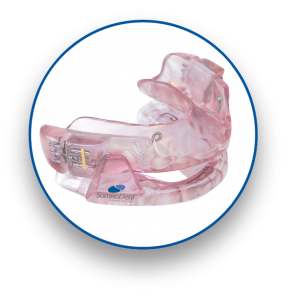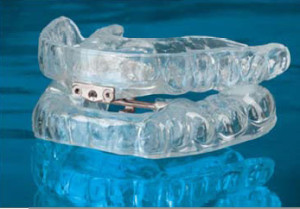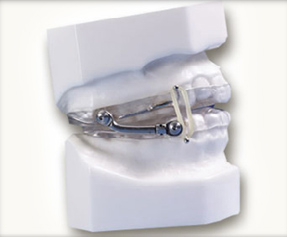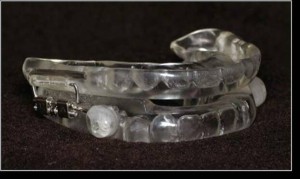Sleep Apnea Mouthpiece
If you have mild to moderate sleep apnea, you may be fitted with a sleep apnea mouthpiece, also called a mouth guard, which, when worn during sleep, helps the air flow better to your lungs and back. Most mouthpieces for sleep apnea are made from acrylic plastic and look a lot like retainers used in orthodontics.
Sleep Apnea Devices
There are several sleep apnea devices you can choose from. The specialist who will fit your device will look at the anatomy of your tongue and your soft palate; he or she will also pay attention as to whether or not you grind your teeth as well as how healthy your teeth and gums are.
These are some devices you might choose from:
Klearway Device
 This is a fascinating thermoplastic device that looks like an athletic mouth guard. You simply heat the device under hot running water so that it can be flexible enough to fit your teeth properly. It keeps your mouth slightly apart so as to be able to sip liquids using a straw in the middle of your mouth. There is hardware at the roof-part of the device that can be adjustable for comfort and ability to work. Swallowing is difficult at first but most people can gradually advance their jaw through the use of the adjustment hardware. Unlike some mouth guards, this one cannot be seen on the outside when worn; however, it can make the tissues around the mouth look swollen.
This is a fascinating thermoplastic device that looks like an athletic mouth guard. You simply heat the device under hot running water so that it can be flexible enough to fit your teeth properly. It keeps your mouth slightly apart so as to be able to sip liquids using a straw in the middle of your mouth. There is hardware at the roof-part of the device that can be adjustable for comfort and ability to work. Swallowing is difficult at first but most people can gradually advance their jaw through the use of the adjustment hardware. Unlike some mouth guards, this one cannot be seen on the outside when worn; however, it can make the tissues around the mouth look swollen.
SomnoDent MAS™
 This is another device that fits over both the upper teeth and the lower teeth. It looks like an athletic mouth guard but serves the function of bringing the jaw forward. It has been shown in research studies to be able to restore a better breathing passageway in the back of the throat.
This is another device that fits over both the upper teeth and the lower teeth. It looks like an athletic mouth guard but serves the function of bringing the jaw forward. It has been shown in research studies to be able to restore a better breathing passageway in the back of the throat.
Modified Herbst Device
This a firm appliance made from hard plastic. It has hardware available for adjusting its fit into your mouth. It makes use of rubber bands that keep the jaw from slipping from side to side but you can open your jaw without difficulty. The downside of this device is that it can crack easily if you tend to grind your teeth vigorously at night.
Elastic Mandibular Advancement (EMA™)
This is a relatively slim device that looks and acts like an orthodontic retainer. It involves using elastic bands that pull the jaw forward. It can be difficult to wear if you aren’t used to having your jaw pulled forward to a large degree.
Adjustable PM Positioner
This is made from acrylic which softens when heated. It is relatively comfortable to wear and can pull the jaw forward by about 4 millimeters. It has adjustable features that allow for advancement of the jaw over a period of time. It is especially popular because the tongue has a lot of room to move.
TAP® 3 Device
 This is custom fit to your mouth and is made of acrylic that softens with heat. It has a separate upper and lower mouth/teeth guards so it is better tolerated by teeth grinders. There is an adjustable device with a part of the device sticking out between your teeth.
This is custom fit to your mouth and is made of acrylic that softens with heat. It has a separate upper and lower mouth/teeth guards so it is better tolerated by teeth grinders. There is an adjustable device with a part of the device sticking out between your teeth.
Tongue Retaining Device

This is an unusual device that has custom made tooth parts and a compartment that sucks the tongue in and keeps it from slipping back into the throat. It is more difficult to adjust to than many of the other appliances out there.
Do sleep apnea mouthpieces really work?
There is research evidence to suggest that using oral appliances effectively manages snoring in up to 90 percent of those who wear them. Sleep apnea is improved by 75 percent, especially if the sleep apnea is mild. Because it isn’t as effective as CPAP machines, a second sleep study usually needs to be performed so that it can be shown effective in opening the airway during sleep.
Oral Appliance for sleep apnea
Oral Appliance Therapy is best used for people who have mild sleep apnea with snoring. They tend to work less effectively among patients with severe sleep apnea. Nevertheless, you should consider trying the oral appliances available to you if you have:
- Heavy snoring
- Inability to tolerate CPAP
- When sleep apnea surgery is not enough
- When you need to travel a lot
- An inadequate sleep apnea device (CPAP)
- Altered bite while awakening in the morning and take the device out for the day
- TMJ symptoms, which involves grinding of the temporomandibular joint
There are two main types of oral appliances that you should be aware of:
Mandibular advancement device (MAD)
- There is a device that comfortably pushes the lower jaw or mandible forward. This opens up the oropharynx in the back of your throat so air moves smoothly. These types of devices are known as mandibular advancement devices (MAD).
Tongue Retaining Device or TRD
- There is a device known as the tongue retaining device or TRD. This is also custom-made to fit your mouth. It is made of a softer material than the MAD device and works by trapping the tongue and pulling forward, making room in the oropharynx for good airflow. This device is best suited for patients who have dentures or who fail to advance the jaw enough with the MAD device.
Sleep Apnea Oral Appliance Side Effects
Side effects include muscle pain in the jaw, bite changes that can be permanent, teeth that are not stable and loosening of any dental work you have done in the past. Chewing can be difficult in up to 20 percent of cases after wearing the device. These devices can permanently change your bite, which can be very uncomfortable.


